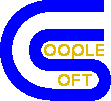CoopleGames is a tool used to make 2-player mobile games, using 2D and 2.5D animation. Android games are written in Java, and iOS games are written in Swift. Games also run on desktop operating systems: Windows, Linux and Mac. When running games in 2-player mode, at least one player must be using a smartphone. When both players are using smartphones, dual-OS games enable one player to be Android and the other player to be iOS. End-users can customize games using a scripting language called JCoople. Game connectivity is accomplished using Bluetooth. CoopleGames also supports development of general Java/Swift/JCoople applications, not just games.
Business Model
Premium mode games enable 2-player mode. Bronze members can only use 2-player mode if their opponent is a silver, gold or platinum member. Bronze and silver members can only use 2-player mode in grayscale, or color if their opponent is a gold or platinum member. Silver, gold and platinum users pay $10, $20 and $30, respectively.
Dimetric Projection
Games are 2.5D using dimetric projection. All planes are parallel or at 90 degree angles with each other, the vantage point of the user is at a 45 degree angle, and all horizontal/vertical lines in the horizontal plane are rendered such that the slope of the line is +/- 0.5 (vertical lines in vertical planes are always vertical). Only horizontal, vertical, and diagonal lines at 45 degree angles are allowed. Since all planes are angled instead of directly facing the user due to the dimetric projection, diagonal lines are not rendered using a slope of 0.5, but have some other slope. Curves are limited to circular arcs in multiples of 45 degrees. Due to the dimetric projection they are rendered as elliptical arcs. Text is monospaced and appears skewed. Labels are allowed which contain a single line of normal text, bounded by a normal rectangle. Labels are always displayed in front of/on top of the dimetric projection.
Animation
Objects can move in 8 directions in 2D mode (90 degree angles and 45 degree angles) and 6 directions in 2.5D mode (up/down, left/right, forward/backward). Objects may include discs and balls. Support for collision detection functionality is provided. The parent object of an animated 2.5D object is assumed to be located on the ground or building directly beneath it. Objects can also dynamically change shape, incrementally or all at once.
Collision Detection
Animation in 2D mode is covered here. All game objects (moving and stationary) have a bounding rectangle. Non-rectangular game objects have a transparent bitmap. A non-rectangular animation region has one or more transparent border bitmaps, which are game objects, usually stationary. Collision detection OR's each pixel in one transparent bitmap with underlying pixel in the other transparent bitmap, detecting a collision upon first OR operation yielding a zero result. Additional logic is required to prevent overshooting a border of a non-rectangular animation region.
